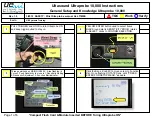
12
13
If no fluoride complexing species are in the sample, TISAB
needn
’
t be added at the same proportions. Add 1 parts
TISAB to 100 parts sample or standard. Ionic strength will
be fixed at approximately 0.02M. Attention: Always pre-
pare samples and standards with the same ISA to volume
ratio.
1) Follow sections VIII and IX to prepare sensors for
measurement.
2) Follow section VI to prepare standards/solution. Stan-
dards should bracket the sample concentration. Stan-
dards and solutions should be at the same tempera-
ture.
1 part of TISAB is added to 100 parts of both samples
and standards. Add stir bar and mix before taking
measurements.
3) Follow section VII; General Guidelines to optimize test
set-up.
4) During calibration it is best to start with lower concen-
tration samples first. Wait for a stable measurement
before recording values. Longer equilibrations are re-
quired at lower concentrations (4-5 minutes).
5) To prevent carry over and contamination of samples,
rinse sensors with deionized water and dab dry be-
tween samples.
For HI 4110 module replacement
1. Drain the fill solution by pressing the upper cap.
Rinse electrode with distilled or deionized water. Drain.
2. Unscrew upper cap and slide down cable toward con-
nector.
3. Move spring and outer body down cable also.
4. Dry off inner stem and module with a soft tissue.
5. Hold inner stem and unscrew module and replace
with a new one. (HI 4110-51).
6. Reassemble electrode (see section VIII), and refill
with electrolyte. Soak new membrane in fluoride
solution to condition before calibration.
XI.
XI.
XI.
XI.
XI. Direct Calibration and Measurement
Direct Calibration and Measurement
Direct Calibration and Measurement
Direct Calibration and Measurement
Direct Calibration and Measurement
This method is a simple procedure for measuring many
samples. A direct reading ISE meter (HI 4212 or equiva-
lent) determines concentration of the unknown by a direct
reading after calibrating the meter with the standards. The
meter is calibrated with two or more freshly made stan-
dards that are in the linear measurement range of the
unknowns. More calibration standards are required in non-
linear regions. Unknowns are read directly.
A pH/mV meter in mV mode with semi log graph paper
may also be used. Two or more freshly prepared standards
that are in the measurement range of the unknowns are
measured in mV mode on the meter.
These values are plotted on the semi-log paper and the
points are connected to form a straight-line curve. When
samples are measured, their mV values are converted to
concentration by following the mV to the concentration axis
on the semi-log plot.
At very low levels of fluoride, special precautions must be
employed for reproducible measurements. Water used for
standards must be fluoride free and sensors and glassware
must be rinsed repeatedly with this water to prevent carry
over. In the region where the electrode calibration becomes
curved, many more calibration points are needed, and
calibration will need to be repeated more frequently.
Typical Linearity for HI 4010 and HI 4110 Sensors
-150.00
-100.00
-50.00
0.00
50.00
100.00
150.00
200.00
250.00
0.00
1.00
2.00
3.00
4.00
5.00
6.00
7.00
8.00
-Log of Concentration
m
V



























